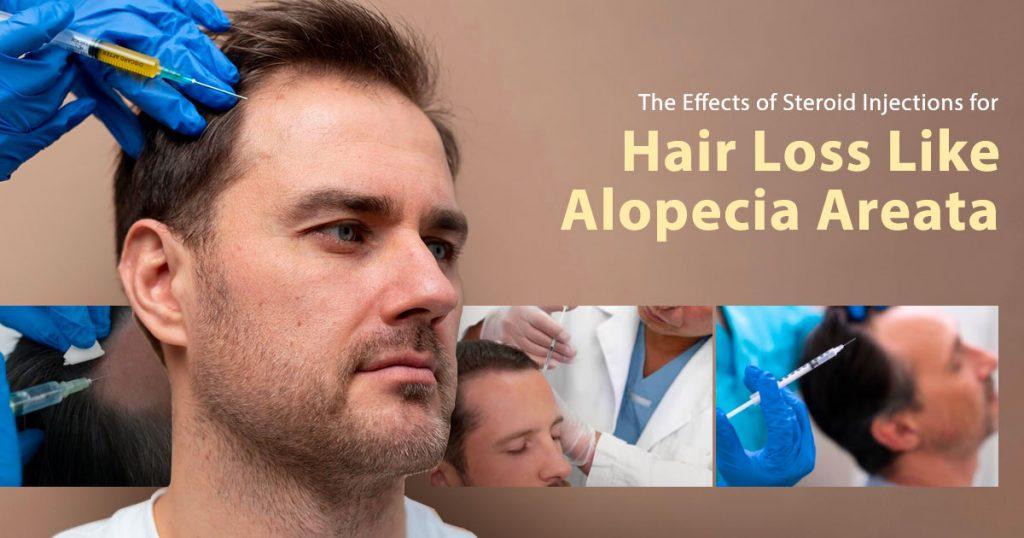Facing hair problems can be challenging and emotionally taxing. Alopecia Areata is one such issue, which causes patches of baldness on the scalp and other parts of the body. Due to the autoimmune nature of the illness, hair follicles are unintentionally attacked by the immune system, causing hair loss. This disorder can affect anyone, regardless of age and gender, and its implications can range from mild hair thinning to complete baldness.
Various treatment options are available for managing Alopecia Areata, ranging from topical treatments to light therapy. However, one of the most common treatments is the use of corticosteroid injections. But how effective are these injections? Let’s delve deeper into this topic.
Understanding Steroids and Their Use in Treating Hair Loss
Steroids can be divided into two categories: anabolic and corticosteroidal. Anabolic steroids are often associated with their use in bodybuilding and performance enhancement, while corticosteroids are used medicinally to treat a variety of conditions.
Corticosteroids, including injectable forms, are frequently used to manage inflammation and immune response in various diseases, including Alopecia Areata. They work by suppressing the immune system and reducing inflammation, which can help prevent the body from attacking hair follicles.
While corticosteroids have many benefits, they also come with potential side effects. These can include skin thinning at the injection site, headache, and changes in skin color. Despite these potential drawbacks, when used properly, corticosteroid injections can be an important tool in the treatment of Alopecia Areata.
Can Corticosteroids Help in Treating Alopecia Areata?
Research has shown that corticosteroids can be effective in treating hair loss caused by Alopecia Areata. A comparative study between fractional carbon dioxide laser and intralesional corticosteroid injection in the treatment of Alopecia Areata found that both methods were effective, but corticosteroid injections had a higher success rate.
Another study found that 71% of patients with alopecia areata and alopecia totalis showed improvement during a 3-month follow-up period after receiving intralesional corticosteroid injections.
However, it’s important to note that while these injections can promote hair growth, they do not cure Alopecia Areata. The effectiveness of the treatment can vary from person to person, and some patients may experience a relapse after discontinuing treatment.
Potential Side Effects of Steroids for Alopecia Areata
Treating alopecia areata with steroids, specifically corticosteroids, can have several potential side effects. While these drugs can be effective in reducing inflammation and suppressing the immune system to stop the body from attacking hair follicles, they also come with risks that should be carefully considered.
Pain and bleeding at the injection site
This is one of the most common side effects and is usually minor.
Soreness in the scalp
Some patients may experience discomfort in the area after the procedure.
Skin atrophy at the injection site
The skin may become thin and weak, making it more susceptible to damage and infection.
Headaches
While relatively rare, some patients may experience headaches after the procedure.
Nausea and vomiting
These are potential systemic side effects of corticosteroid use.
Flushing
Some patients may experience a temporary reddening of the skin.
Transient hyperglycemia
High blood sugar levels can occur, particularly in individuals with diabetes.
Changes in mood or behavior
Some patients may experience emotional changes as a result of corticosteroid use.
Weight gain
Oral steroids like prednisone can lead to weight gain.
Long-term systemic effects
Corticosteroid use for an extended period of time can result in serious health problems such as diabetes, high blood pressure, and bone thinning.
Weighing the Benefits and Drawbacks
Alopecia areata patients should carefully consider the potential advantages of corticosteroids versus any potential drawbacks before deciding to use them. Corticosteroids have the ability to suppress the immune system and reduce inflammation, which may promote hair growth. This can significantly improve a patient’s self-esteem and appearance.
However, these advantages must be balanced against the risks. These can range from minor discomfort at the injection site to more serious systemic effects like high blood pressure, diabetes, and bone thinning with long-term use.
Steroid Shots for Hair Loss: Is It Worth the Risks?
Whether corticosteroid treatment is worth the risks is highly individual and depends on several factors. These include the severity of the alopecia areata, the patient’s overall health, and their personal comfort with the potential side effects.
For some patients, the chance of hair regrowth may outweigh the potential side effects, particularly if other treatments have not been effective. For others, the possible side effects may be too daunting, leading them to explore other treatment options.
In conclusion, it’s crucial for each patient to have a thorough discussion with their healthcare provider about the potential benefits and risks of corticosteroid treatment, as well as other available treatments, to make an informed decision that best suits their situation.
